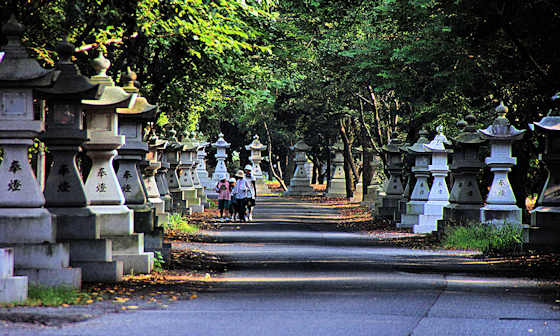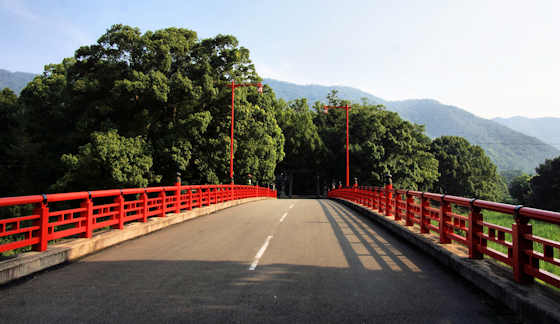Sunday, December 4, 2011
Art of Manidera
Saturday, December 3, 2011
On the henro trail
Sorry for the scarcity of posts recently. have been down in Shikoku on the henro trail.
Normal service will resume shortly
Labels:
iwaishima
Saturday, November 26, 2011
Oasahiko Shrine
Hemp was a very important plant in Japan until Shogun Macarthur outlawed it during the occupation.
Labels:
engi shiki,
hemp,
henro,
imbe,
sarutahiko,
shikoku,
Shrine,
tokushima
Monday, November 21, 2011
Cosplay
Well, this is something you probably thought you would never see on this blog, and it is something that surprises me too. Cosplay!
Last week I went up to Enchoen, a huge Chinese garden in Tottori, and when I walked in I was surprised to see lots of kids dressed up in cosplay. Apparently I had stumbled in to the 11th Annual Pan-Asian Cosplay Competition.
There were kids from China, Taiwan, Korea, Thailand, and of course Japan. They all had tons of high-end camera equipment and spent their time posing and shooting....
I dont read manga nor watch anime, so I have absolutely no idea who any of these characters are...
Saturday, November 19, 2011
Typical Japanese Landscape 30
Probably my favorite landscape views of Japan are from on high looking down on mist filled valleys.
All these shots are from dawn a couple of weeks ago up on Mt Hiba and Mt Eboshi, at around 1200 meters in the Chugoku Mountains stradding the border of Hiroshima and Shimane.
Someone wrote me and suggested I give more detailed info on the locations of my posts, so I have started to add google maps at the bottom of the posts. Is this helpful?
In actual fact, as is the case with much of life, the best Japan has to offer is not easily accessible.
View Larger Map
Thursday, November 17, 2011
Onbashi. The biggest natural bridge in Japan
Labels:
drainspotting,
hiroshima,
manhole
Tuesday, November 15, 2011
Kamo Culture Hall
This is one of the more bizarre buildings I have come across in rural japan, its the Kamo Culture Hall in the small town of Kamo, now part of Unnan Town up in Izumo.
Kamo has a population of about 6,000, and yet has this huge concert hall and conference center. many smaller towns and villages in Shimane have such facilities. Maybe we in Shimane are an especially cultured people, or maybe before the bubble burst japan poured insane amounts of money into useless construction.
There is an element of fantasy in the design, and it also seems to be a mishmash of influences. I must admit that on first viewing from a distance I though it might have been a nuclear power station or some sort of industrial complex.
It was built in 1994 and the architect is Toyokazu Watanabe, not someone I have heard of before, but seems fairly well known for his "Breast House" in Kyoto.
Kamo is in the area of Izumo where the Yamata no Orochi myth is set, and according to the architect this was an influence on his design....
Labels:
Architecture,
Izumo,
toyokazu watanabe
Monday, November 14, 2011
Konsenji Temple 3 Shikoku Pilgrimage
Konsenji Temple 3 Shikoku Pilgrimage
Thursday, November 10, 2011
Vacation 2011 Day 8 To Ali's Gate
I was so excited to be back in the desert that I slept little so was able to climb to a high point to watch the sunrise....
Mother earth was naked, pure rock with no clothing of vegetation. The homes were built out of the same material and blended in as well as being lost in scale....
As a general rule the Berber do not like to be photographed, but there are exceptions......
We climbed gradually and steadily all day, further into the Jebel Sahro
By lunchtime we reached bab'm ali, Alis gate, two huge outcroppings...
We camped at an intersection of 4-wheel drive tracks. There was a small gite here with a cafe....
Sunsets were as awesome as the sunrises.....
Wednesday, November 9, 2011
Kanzui Matsuri 2
For various reasons I only managed to get to one matsuri this Autumn, so I thought I would post on each dance in a little more detail.
The second dance is kamimukae, the welcoming of the gods.
kagura, like other "entertainments" at shrines is put on primarily for the kami, but fortunately the kami enjoy the same kinds of things as we mortals. After the space has been suitably purified the kami are welcomed. This is a shinji, a ceremonial rather than theatrical dance and is usually danced by 4 dancers, though I haver seen it danced with a single dancer.
Here at kanzui it was danced by only three, and like some other shrines Ive been to it was presented by the youngest members of the troupe, and is usually one of the first dances learnt by beginners.
The kids were very nervous, its possible that this was the first time they had performed this dance publicly, and the leader was seated just offstage to offer prompts. 2 of the dancers were girls. In recent years girls have started to dance kagura, though as yet I have not seen any dance any of the theatrical pieces. Girls playing the instruments is far more common.
kagura, like other "entertainments" at shrines is put on primarily for the kami, but fortunately the kami enjoy the same kinds of things as we mortals. After the space has been suitably purified the kami are welcomed. This is a shinji, a ceremonial rather than theatrical dance and is usually danced by 4 dancers, though I haver seen it danced with a single dancer.
Here at kanzui it was danced by only three, and like some other shrines Ive been to it was presented by the youngest members of the troupe, and is usually one of the first dances learnt by beginners.
The kids were very nervous, its possible that this was the first time they had performed this dance publicly, and the leader was seated just offstage to offer prompts. 2 of the dancers were girls. In recent years girls have started to dance kagura, though as yet I have not seen any dance any of the theatrical pieces. Girls playing the instruments is far more common.
Labels:
Iwami Kagura,
kamimukae,
kanzui,
Matsuri
Subscribe to:
Posts (Atom)






































